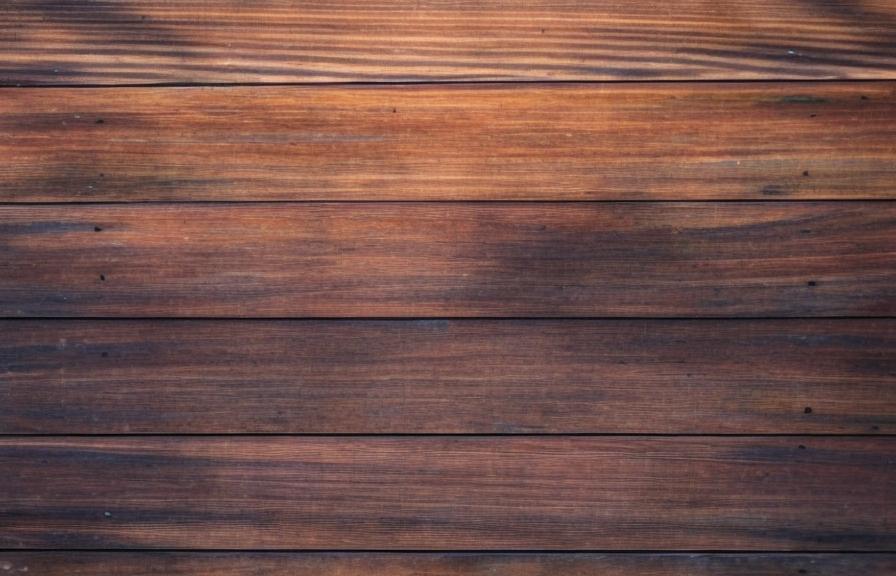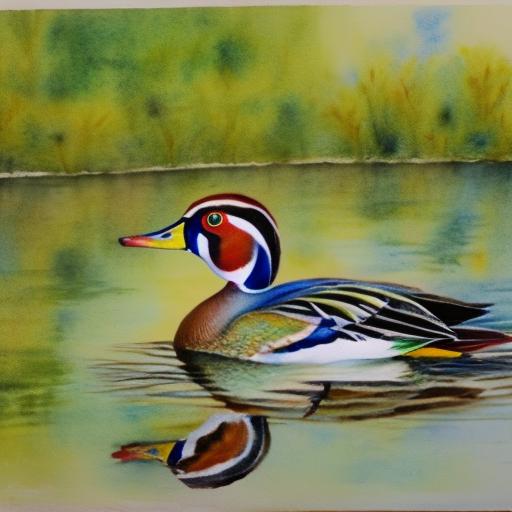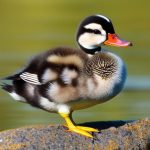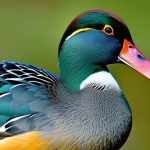Wood ducks, scientifically known as Aix sponsa, are one of the most stunning and colorful waterfowl species found in North America. These beautiful birds are known for their vibrant plumage, with males sporting iridescent green and purple heads, red eyes, and distinctive patterns on their bodies, while females have a more subtle appearance with a grayish-brown plumage and a white teardrop-shaped eye ring. Wood ducks are commonly found in wooded swamps, marshes, and shallow lakes, where they can easily access their preferred diet of acorns, seeds, and insects.
The breeding season for wood ducks typically occurs in the spring, from March to June, when these birds engage in elaborate courtship displays and nesting behaviors. During this time, wood ducks can be observed engaging in fascinating mating rituals and building their nests in tree cavities or nest boxes near water bodies. The breeding season is a critical time for wood ducks, as it is essential for the survival and growth of their populations. In this article, we will explore the characteristics of wood duck breeding season, the factors affecting it, signs of breeding behavior, nesting and mating behavior, conservation efforts during this time, and the future of wood duck breeding season.
Key Takeaways
- Wood ducks are colorful and unique waterfowl species found in North America, known for their stunning plumage and distinctive breeding habits.
- During the breeding season, male wood ducks display vibrant colors and intricate patterns to attract females, while females seek out suitable nesting sites.
- Factors such as habitat loss, predation, and human disturbance can impact the success of wood duck breeding season, leading to population declines.
- Signs of wood duck breeding season include courtship displays, vocalizations, and the selection of nesting cavities in trees or nest boxes near water.
- Wood ducks exhibit interesting nesting and mating behaviors, with females typically laying a clutch of eggs in a well-hidden nest and males providing protection. Conservation efforts, such as habitat restoration and nest box programs, play a crucial role in supporting wood duck breeding season and ensuring their future survival.
Characteristics of Wood Duck Breeding Season
The breeding season for wood ducks is a time of heightened activity and vibrant displays as these birds prepare to mate and raise their young. During this time, male wood ducks engage in elaborate courtship displays to attract females, showcasing their colorful plumage and performing intricate movements such as head bobbing, wing flapping, and vocalizations. These displays are not only visually stunning but also serve as a way for males to establish dominance and attract potential mates.
Female wood ducks are also actively involved in the breeding season, carefully selecting suitable nesting sites and preparing their nests for egg-laying. Wood ducks are cavity nesters, meaning they seek out tree hollows or nest boxes near water bodies to build their nests. Once a suitable site is found, females line their nests with down feathers to provide insulation and protection for their eggs. The breeding season is also marked by the laying of eggs, with females typically laying around 10-15 eggs over a period of several days before incubation begins.
Factors Affecting Wood Duck Breeding Season
Several factors can influence the breeding season of wood ducks, including environmental conditions, habitat availability, and predator pressure. One of the most critical factors affecting wood duck breeding season is the availability of suitable nesting sites. As cavity nesters, wood ducks rely on tree hollows or nest boxes near water bodies to build their nests and raise their young. Loss of suitable nesting habitat due to deforestation, urbanization, or habitat degradation can significantly impact the breeding success of wood ducks.
Environmental conditions such as temperature and precipitation can also influence the timing and success of the breeding season. Unseasonably cold or wet weather can delay nesting activities and reduce the survival rate of eggs and hatchlings. Additionally, predator pressure from animals such as raccoons, snakes, and birds of prey can pose a significant threat to wood duck nests and offspring. Conservation efforts aimed at addressing these factors, such as habitat restoration, predator control, and monitoring of environmental conditions, play a crucial role in supporting the breeding success of wood ducks.
Signs of Wood Duck Breeding Season
During the breeding season, there are several distinct signs that indicate the onset of mating behavior and nesting activities in wood ducks. One of the most noticeable signs is the presence of male wood ducks engaging in elaborate courtship displays to attract females. These displays often involve vibrant plumage, intricate movements, and vocalizations that can be observed near water bodies where wood ducks congregate.
Another sign of the breeding season is the active search for suitable nesting sites by female wood ducks. These birds carefully inspect tree hollows or nest boxes near water bodies, often accompanied by males who may vocalize or display nearby to attract their attention. Once a suitable site is found, females begin the process of preparing their nests by lining them with down feathers in preparation for egg-laying.
The laying of eggs is another clear indication of the breeding season for wood ducks. Females typically lay one egg per day over a period of several days until they have laid a full clutch of eggs. This process is often accompanied by increased activity around the nest site as both males and females work together to ensure the success of their offspring.
Nesting and Mating Behavior of Wood Ducks
Nesting and mating behavior are integral components of the breeding season for wood ducks, as these activities are essential for the successful reproduction and survival of their offspring. As cavity nesters, wood ducks seek out suitable nesting sites in tree hollows or nest boxes near water bodies. Once a site is selected, females line their nests with down feathers to provide insulation and protection for their eggs.
Mating behavior in wood ducks involves elaborate courtship displays by males to attract females. These displays often include vibrant plumage, intricate movements, and vocalizations that serve as a way for males to establish dominance and attract potential mates. Once a pair bond is formed, males and females work together to ensure the success of their nesting activities and the raising of their young.
After laying a full clutch of eggs, females begin the process of incubation, during which they diligently tend to their eggs to ensure their survival. Incubation typically lasts around 30 days, during which time females remain dedicated to keeping their eggs warm and protected from potential threats. Once the eggs hatch, both parents are actively involved in caring for their offspring, providing them with food and protection until they are ready to fledge.
Conservation Efforts during Wood Duck Breeding Season

Conservation efforts during the wood duck breeding season play a crucial role in supporting the reproductive success and population growth of these stunning waterfowl. One of the most significant conservation efforts is the establishment and maintenance of nest boxes in suitable habitats to provide additional nesting sites for wood ducks. These nest boxes mimic natural tree hollows and offer protection from predators, helping to increase the breeding success of wood ducks.
Habitat restoration is another essential conservation effort during the breeding season, aimed at preserving and enhancing suitable nesting habitats for wood ducks. This may involve reforestation efforts, wetland restoration, and the creation of buffer zones around water bodies to protect nesting sites from disturbance.
Predator control is also an important aspect of conservation efforts during the breeding season, as it helps reduce the threat posed by predators such as raccoons, snakes, and birds of prey to wood duck nests and offspring. Monitoring environmental conditions such as temperature and precipitation is crucial for understanding how these factors may impact the breeding success of wood ducks and implementing appropriate management strategies.
Conclusion and Future of Wood Duck Breeding Season
In conclusion, the breeding season for wood ducks is a time of heightened activity and vibrant displays as these stunning waterfowl prepare to mate and raise their young. The characteristics of wood duck breeding season include elaborate courtship displays, nesting activities, egg-laying, incubation, and caring for offspring. Several factors can influence the breeding season of wood ducks, including habitat availability, environmental conditions, and predator pressure.
Conservation efforts during the wood duck breeding season are essential for supporting the reproductive success and population growth of these beautiful birds. By establishing nest boxes, restoring habitats, implementing predator control measures, and monitoring environmental conditions, we can help ensure the future of wood duck breeding season and contribute to the conservation of this iconic species.
Looking ahead, continued efforts to protect and enhance suitable nesting habitats for wood ducks will be crucial for maintaining healthy populations and ensuring the long-term survival of these stunning waterfowl. By working together to address the factors affecting wood duck breeding season and implementing effective conservation strategies, we can help secure a bright future for these beautiful birds for generations to come.
If you’re interested in learning more about breeding ducks, you might also want to check out this informative article on do quails sit on their eggs. It provides valuable insights into the breeding behaviors of quails and offers helpful tips for successful breeding. Whether you’re considering raising ducks or quails, understanding their breeding seasons and behaviors is essential for a successful and fulfilling experience.
FAQs
What is the breeding season for wood ducks?
The breeding season for wood ducks typically occurs from late winter to early summer, with peak activity in the spring months.
What are the signs of wood duck breeding season?
During breeding season, male wood ducks display vibrant plumage and engage in courtship displays to attract females. Females will also seek out suitable nesting sites and lay eggs.
How long does the wood duck breeding season last?
The wood duck breeding season can last for several months, with nesting, egg-laying, and hatching occurring during this time.
Where do wood ducks typically breed?
Wood ducks often breed in wooded wetlands, swamps, and marshes with access to water for nesting and raising their young.
Do wood ducks mate for life?
Wood ducks do not mate for life. They form new pair bonds each breeding season, and males may mate with multiple females.
Are there any conservation efforts to protect wood duck breeding habitats?
Conservation organizations and wildlife agencies work to protect and restore wetland habitats that are crucial for wood duck breeding, as well as implementing nest box programs to provide additional nesting sites for wood ducks.
Meet Walter, the feathered-friend fanatic of Florida! Nestled in the sunshine state, Walter struts through life with his feathered companions, clucking his way to happiness. With a coop that’s fancier than a five-star hotel, he’s the Don Juan of the chicken world. When he’s not teaching his hens to do the cha-cha, you’ll find him in a heated debate with his prized rooster, Sir Clucks-a-Lot. Walter’s poultry passion is no yolk; he’s the sunny-side-up guy you never knew you needed in your flock of friends!







